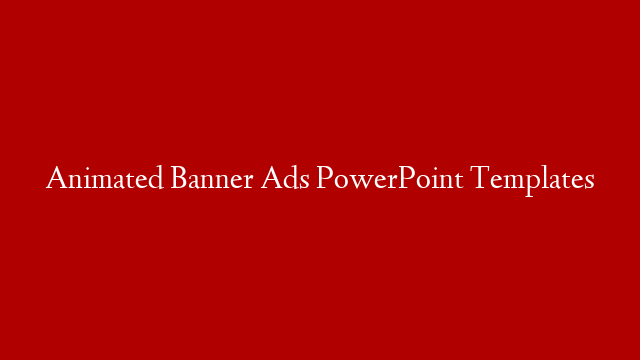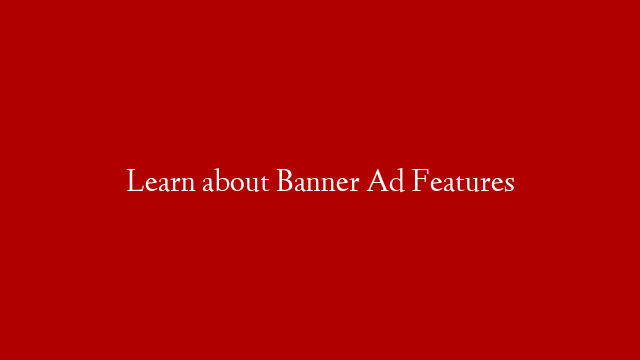
What you need to know before you start putting them up
Unique to other advertising vehicles, the Internet has the ability to target customers within a specific demographic and deliver television-like advertisements.
According to Juniper Research, these are the two reasons online advertising spend is growing rapidly and has overtaken that spent on magazine advertising. Senior analyst, Gary Stein predicts online spending to rise to $15 billion, compared with $14.5 billion for magazine ad spends.
From data compiled by Juniper Media Metrix, an astounding 80 percent of advertisers use the banner and 18 of every 25 online ads created by advertisers are banners. Why? Popularity is possibly caused by banners’ ability to mimic what marketers are used to using – magazine and newspaper advertisements. They absorb a small amount of website real estate to promote a product, service, brand or other message. Similarly, where each ad is placed can be carefully tuned toward the demographic audience.
About Banner Advertising
Marketers have found a difference in success due to ad animation functioning. Many ads now include streaming video, and audio either playing the television commercial or made-for-online custom clips. Current trends in banner marketing include animated GIF (Graphic Interchange Format) image files, shockwave or flash games and electronic forms.
A study conducted by ZD Net found animated ads generate at least 15 percent more click-through rates than do static ads – in some cases as high as 40 percent more.
People notice animation, whether or not they actually click on it. So the message gets across. But even with animation in an advertisement, the message must be carefully crafted and convincing with a clear call to action. The animation itself doesn’t replace response-driven copy.
- Bright Colors are more effective
- Sense of urgency in message decreases response
- Banners at the top of the page are twice as effective
Usability studies were also conducted on participants from Wichita State University to critique and fine-tune the best overall combination of placement and animation within banner advertising. Findings showed 40 percent of the participants were able to recall the presence of at least one ad regardless of its animated or static design. Yet animation itself didn’t seem to play that high of a role.
Viewers recalled the presence of animation and movement on the page, but not necessarily the purpose behind it. Also many viewers were able to recall the ad itself, but not the company name. Name and brand integration within the design, thus, should play an important aspect in design. The study authors encouraged ongoing studies around duration and type of animation to fine-tune the effects of animation on banner ad awareness.
Even those visitors who view a banner ad and don’t click immediately tend to eventually purchase from the advertiser. Though, according to AdKnowlege stats cited by NUA, this does stretch the purchase cycle. They state: “Almost 40 percent of those who viewed an ad and then made a purchase did so eight to 30 days after seeing the ad, while 61 percent of consumers who clicked an ad before purchasing did so within 30 minutes of clicking.”
The focus of banner ads are not necessarily the CTR gained, but the brand visibility they create for the long-term marketing strategy.
Develop ads with minimal words, about six to ten, using short, simple words in big typeface. Graphic quality can make or break the reputation. So enhance visuals to gain the viewers’ attention. Copy should be written for the viewer’s benefit with a strong call to action encouraging a click for more information, sign-up or purchase.
Where Can You Advertise
Google AdWords include image ads with easy set-up. Advertisers can create a banner ad campaign through Google AdWords or by joining the content network in their current account and uploading an image ad.
To Roll It Up
The Internet gives advertisers the capability to target customers within a specific demographic and deliver television-like banner advertisements. Online spending is now rising to over $15 billion, compared with $14.5 billion for magazine ad spends. Plus, unlike text and PPC advertising, banners give merchants the capability to enforce their brand image using the business logo and trademark graphics.
Data compiled by Juniper Media Metrix shows that 80 percent of advertisers use the banner and 18 of every 25 online ads created by advertisers are banners. Trends in banner marketing utilize animated GIF (Graphic Interchange Format) image files, shockwave or flash games and electronic forms.
Don’t Hurt Your Advertisements!
2 things that hurt a banner ad’s success rate are long download times and poorly crafted copy. Though with higher and faster connectivity options, download time should become less and less important.
Location and page placement are other important consideration. In research conducted by DoubleClick, key areas were identified for total ad success. These are:
- After the fourth impression, response rates dropped from 2.7% to under 1% (banner burnout)
- Focus on creativity, targeting, frequency and content
- Cryptic messages may increase click-through by 18%, but they may not attract the right audience or reinforce branding
- Using questions can raise click-through rates by 16%
- Phrases such as “Click Here” tend to improve response 15%
- Offering free goods or services generally improve click-through rates


